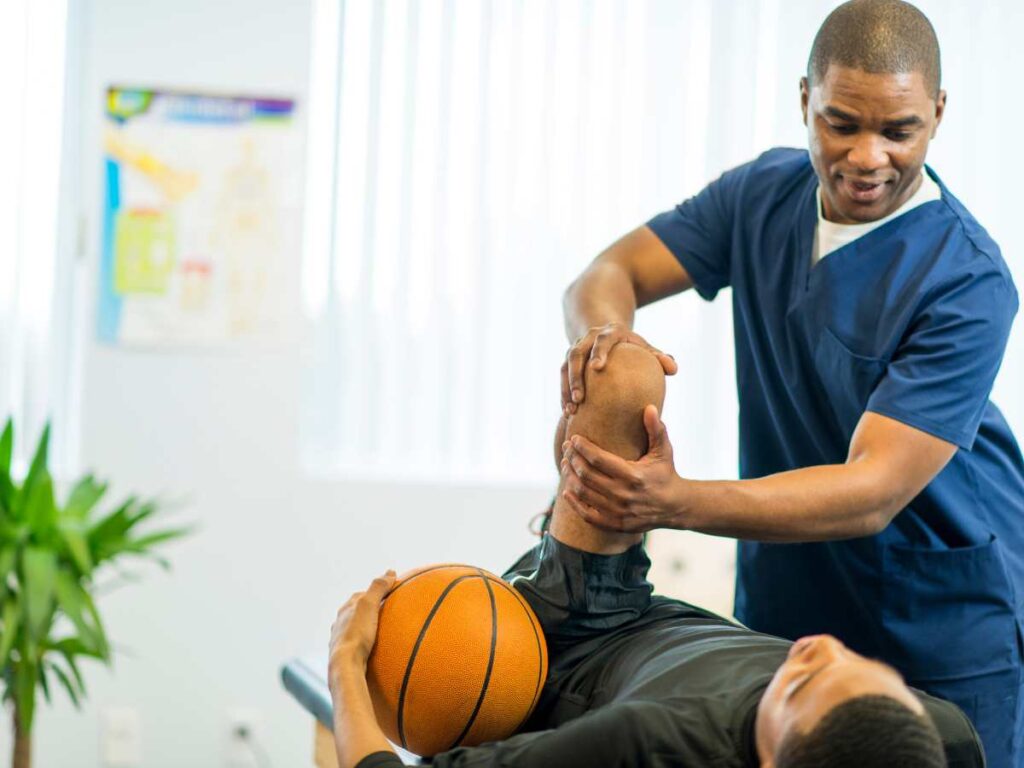Introduction
Sports and physical therapy are two fields that, at first glance, might not seem closely related. However, the role of physical therapist for athletes in the world of sports is crucial for achieving peak performance.
In this article, we will delve into the ever-changing nature of the partnership between athletes and physical therapists, shedding light on the various aspects of their collaboration.
The Role of Physical Therapists in Sports
Sports physical therapists specialize in sports medicine, optimizing movement and level of function, particularly in sports. They play a crucial role in keeping athletes healthy and injury-free, as well as designing training programs to enhance an athlete’s performance. They work closely with athletes to assess, diagnose, and treat injuries, as well as provide preventive care to ensure professional athletes perform at their best.
In a study about preventing injuries, most athletes (about 76%) said they wanted to talk to a physical therapist about how to avoid getting hurt.
The Importance of Physical Therapy for Athletes
Physical therapy for athletes is crucial because it aids in injury prevention, shorter recovery times, and enhanced performance. Athletes subject their bodies to rigorous training and competition, making them more susceptible to injuries.
Regular physical therapy sessions, often tailored through specialized care plans, help athletes find and fix minor problems before they turn into big ones, making sure they stay in good shape and perform their best in their sports.
How Athletes Benefit from Physical Therapy
The benefits of physical therapy for athletes in medical care are evident in various ways, making it an indispensable component of their training and overall well-being. Let’s delve into the various facets that highlight the profound impact of physical therapy’s advanced treatments on athletes’ lives and performance.
Rehabilitating from injury or surgery
Sports physical therapists guide athletes through the recovery process after sports injuries, including chronic injuries or surgery. They are experts at ensuring that athletes get better safely and reduce recovery time to regain their strength and ability to move quickly.
Increasing Strength
Strength training programs enhance an athlete’s muscular strength and conditioning. This not only helps in preventing injuries but also significantly boosts athletic performance.
Eliminating Pain
One of the principal objectives of physical therapy for athletes is to provide effective pain relief. They use various techniques to alleviate pain and muscle tension, enabling athletes to perform without discomfort. Whether addressing chronic pain or managing pain stemming from an injury, these therapists are crucial in ensuring athletes can compete at their best.
Increasing Mobility
Mobility is crucial in sports. Therapists work on improving an athlete’s range of motion, ensuring they can move freely and efficiently.
Sports Performance Enhancement
Physical therapists for athletes don’t just focus on rehabilitation; they also work on optimizing an athlete’s sports performance. This includes developing specific athletic programs to enhance an athlete’s physical strength and address muscle imbalances.
Injury Prevention
Through assessments and personalized physical therapy programs, physical therapists for athletes actively work to prevent future injuries. Their expertise in biomechanical analysis helps athletes understand how to reduce the risk of getting hurt during training and competitions.
By tailoring training plans to an athlete’s specific needs, physical therapists can address weaknesses or imbalances, ultimately reducing the likelihood of injuries during physical activity on the playing field.
Why is Collaboration Between Physical Therapists and Athletes Important?
Collaboration between physical therapists and athletes is vital for several reasons. It ensures that athletes receive the best care possible, leading to a faster healing process and better performance. Therapists customize their physical therapy treatment plan to suit the unique needs of each athlete, encompassing a wide range of considerations such as their sport, position, and individual goals. This tailored approach significantly contributes to an athlete’s success in sports.
What do Physical Therapists Gain from Collaborating with Athletes?
Physical therapists also benefit from collaborating with athletes. They gain valuable experience in dealing with sports-related injuries and conditions, which plays a significant role in enhancing their skills in athletic training and their physical therapy career. This experience not only enhances their skills but also opens up opportunities for specialization in sports physical therapy.
As a result, this can pave the way for career advancement, allowing them to become experts in sports medicine and work with high-level athletes in various sports. Working closely with sports teams provides them with insights and expertise that can be invaluable in their careers as sports physical therapists.
Conclusion
The collaboration between physical therapists and athletes offers a broad range of benefits. It is a symbiotic relationship that results in success in sports. Athletes receive expert care and guidance, while therapists gain valuable experience and expertise, leveling the playing field for athletes. This partnership is a testament to the importance of teamwork and specialized care in achieving success in sports.
If you’re an athlete looking to overcome athletic injuries or enhance your performance while prioritizing your physical health, consider exploring Up and Running Physical Therapy. Their expertise can be the key to your success in sports.


